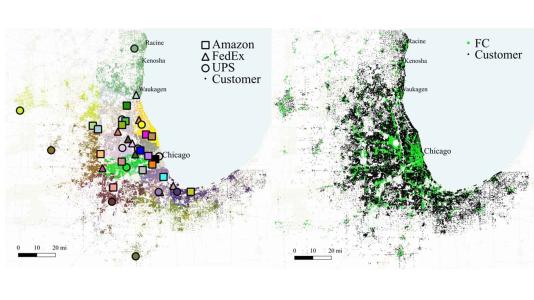アリゾナ大学のエンジニアは、自律走行車が宇宙飛行士のための地下居住地を偵察するシステムを開発しました。 University of Arizona engineers have developed a system that allows autonomous vehicles to scout out underground habitats for astronauts.
2023-03-01 アリゾナ大学
 In this artist’s impression of the breadcrumb scenario, autonomous rovers can be seen exploring a lava tube after being deployed by a mother rover that remains at the entrance to maintain contact with an orbiter or a blimp.John Fowler/Wikimedia Commons, Mark Tarbell and Wolfgang Fink/University of Arizona
In this artist’s impression of the breadcrumb scenario, autonomous rovers can be seen exploring a lava tube after being deployed by a mother rover that remains at the entrance to maintain contact with an orbiter or a blimp.John Fowler/Wikimedia Commons, Mark Tarbell and Wolfgang Fink/University of Arizona
自律型ローバーが、通信ネットワークを介して情報を共有し、独立して探査できるよう、各ロボットには特定の小型センサーが搭載されている。
研究者たちは、このシステムを「Breadcrumb-Style Dynamically Deployed Communication Network(DDCN)」と呼んでおり、NASAの宇宙技術グランドチャレンジに対応するものであるとされている。
今後は、このシステムを活用し、月面や小惑星、彗星、火星の地下探査に取り組む計画もあるという。
<関連情報>
- https://news.arizona.edu/story/hansel-and-gretels-breadcrumb-trick-inspires-robotic-exploration-caves-mars-and-beyond
- https://www.sciencedirect.com/science/article/abs/pii/S0273117723001187?via%3Dihub
惑星地下探査のためのメッシュトポロジーを用いたヘンゼルとグレーテルのパンくず型動的展開通信ネットワークパラダイム A Hansel & Gretel Breadcrumb-Style Dynamically Deployed Communication Network Paradigm using Mesh Topology for Planetary Subsurface Exploration
Wolfgang Fink, Connor Fuhrman, Andres Nuncio Zuniga, Mark Tarbell
Advances in Space Research Available online :11 February 2023
DOI:https://doi.org/10.1016/j.asr.2023.02.012
Abstract
We introduce a dynamically deployed communication network (DDCN) paradigm using mesh topology in support of a distributed robotic multi-agent approach for the autonomous exploration of subsurface environments, i.e., caves, lava tube caves, lakes, and oceans, etc. The DDCN, comprising wireless communication beacons autonomously deployed via a rover or submersible in a Hansel & Gretel-inspired breadcrumb style, allows for the longest and most robust communication link between subterranean robotic agent(s) within, e.g., a lave tube cave or a subsurface ocean, and associated surface-borne robotic agent(s). Moreover, we briefly touch on the development of a robotic testbed and wired/wireless communication beacons in support of such astrobiological surface/subsurface exploration scenarios. Candidate lava tube caves have been identified on the Moon and Mars, raising possibilities for planetary exploration, astrobiology, habitat construction for future astronauts, and potential mining operations. Subterranean caverns, and in particular relatively deep lava tube caves, provide a possible refuge for life under otherwise challenging planetary surface conditions, and, as such, are of prime astrobiological relevance. Lava tube caves or other subsurface environments may also be suitable habitats for astronauts and subsequent human settlement but are yet to be explored in part due to difficulties ensuring continued communication with a robotic probe inside these environments. Moreover, the existence of subsurface oceans on ocean worlds, such as Europa, Enceladus, and Titan, has been backed by varying levels of evidence since the 1980s, though there has been no confirmation, i.e., direct observation, thus far. Such environments are also shielded from radiation and, in combination with the hypothesized presence of water, are additional candidate environments for finding extant or fossilized life. The DDCN paradigm introduced herein directly addresses NASA’s Space Technology Grand Challenges – “All Access Mobility” by enabling the most unconstrained exploration of subsurface environments through a dynamic communication network which ensures transmission of data from and possibly commands to the subsurface robotic probe.



